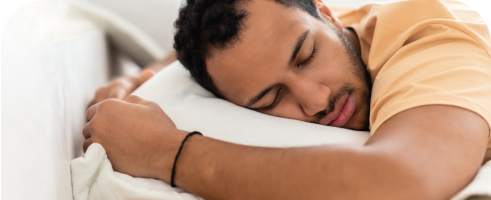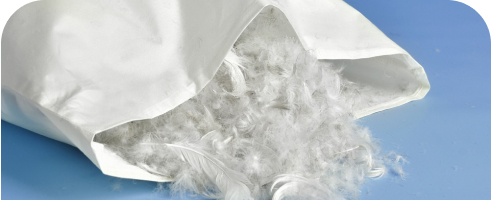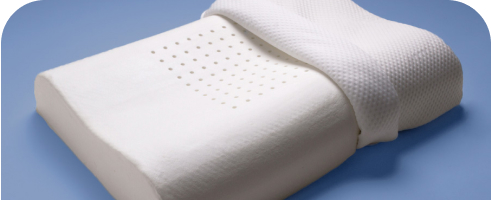How to Wash Silk Pillowcases
Should You Hand-Wash or Machine-Wash?
Silk is made from a fiber silkworms create to make cocoons. When spun and woven into fabric, silk is soft, shiny, and strong. As bedding, silk is gentler on hair than other materials, wicks moisture away without absorbing much of it, naturally regulates temperature, and some studies have found that silk can ease inflamed skin. Many people also claim that silk pillowcases cause fewer wrinkles by being easier on the skin, but rigorous clinical studies haven’t outright proven this.
With all these benefits, there is a downside: silk is a sensitive fabric. Silk requires special care and not all silk can be washed in the washer and dryer like other fabrics. We’ll walk you through everything you need to know to wash a silk pillowcase.
Find a Pillow That’s Right for You
Looking for a new pillow? Take the quiz below to find the perfect pillow for your needs.
Trouble sleeping?
Answer these 5 easy questions to discover your perfect pillow

Trouble sleeping?
Answer these 5 easy questions to discover your perfect pillow
What position do you sleep in?

Side

Back

Stomach
Important: Before You Start
Before beginning to wash your silk pillowcase, check your product’s label or tag. The manufacturer likely provided care instructions. Since different silk fabrics are made differently, following care instructions can ensure that you’re washing your pillowcases in the best way for them. Some silk pillowcases can go in the washer and dryer, while others must be hand-washed. Others even require dry cleaning.
What You’ll Need
Make sure you have these items before beginning:
- Clean bucket, basin, or sink
- Cool, clean water
- Gentle detergent or distilled white vinegar
- Large bath towel
- Mesh laundry bag
If you choose to wash your silk with detergent instead of vinegar, make sure it specifically says for silk or delicates on the label. Enzyme cleansers and harsh powder detergents can damage silk.
How to Hand-Wash a Silk Pillowcase: Step-by-Step
- Look over the pillowcase for spots or stains. Pretreat the stains with a few drops of detergent, gently massaging each spot with your finger.
- Fill your basin with cool water.
- Turn the pillowcase inside out.
- Place the pillowcase in the basin and push it beneath the water.
- Add a few drops of detergent or a half cup of distilled white vinegar to the water.
- Very gently massage the pillowcase with your fingers, without rubbing it against itself.
- Once it seems clean, rinse the pillowcase with cold water.
- Lightly press the pillowcase between your hands over the basin to help remove water from it. Do not scrunch it up, wring it out, or squeeze it, since that can damage the pillowcase.
- Lay a clean towel on a flat surface, then lay the pillowcase on top of the towel. Gently roll the towel and pillowcase up to absorb moisture, then unroll them and let the pillowcase air dry on top of the towel.
How to Machine-Wash a Silk Pillowcase: Step-by-Step
- As with handwashing, first look over the pillowcase for spots or stains. Pretreat the stains with a few drops of detergent, gently massaging each spot with your finger.
- Check your pillowcase’s tag to make sure it can be put in the washing machine. If it can, put it in a mesh laundry bag, close the bag, then put the bag in the machine
- Add a small amount of gentle detergent for silks or delicates to the machine. Alternatively, add half a cup of distilled white vinegar to the machine.
- If the machine has a setting specifically for silks, choose that. If not, choose a gentle or delicates cycle with cold water and turn the machine on.
- Once the wash cycle is complete, immediately remove the mesh bag from the machine and the pillowcase from the mesh bag. If the pillowcase sits in the washer for too long, it may wrinkle.
How to Dry a Silk Pillowcase
- Check the tag of your silk pillowcase to see if it can be dried in a dryer. Some silk can be dried in a dryer, but using a dryer comes with a greater risk of damaging the silk. If it can be dried in a dryer and that is what you would like to do, put the pillowcase in the dryer.
- Do not add dryer balls or fabric softener sheets to the dryer.
- Select an “air dry” or “no heat” dryer setting.
- Turn the dryer on.
- Remove the pillowcase as soon as the dryer has finished drying.
If your silk pillowcase cannot be dried in the dryer, or if you would prefer not to dry it that way, place the wet pillowcase on a bath towel lying on a flat surface. From there, gently roll the towel and pillowcase up to absorb moisture, then unroll them and let the pillowcase air dry.
Last Tips to Care for Silk Pillowcases
Although silk needs to be taken care of more carefully than other fabrics, silk bedding and pillowcases can still last a long time and provide comfort. Here are tips for helping your silk pillowcase last as long as possible:
- Stain removal: Remove stains gently, applying gentle detergent with your hands. Do not use stain sticks or sprays, and do not scrub stains with a brush or sponge.
- Washing frequency: Since your pillowcases directly touch your skin, washing them regularly is important. Consider washing your silk pillowcases every week or every other week.
- Steaming: If your silk pillowcases develop wrinkles, you may steam them using a steamer. The steam may also help kill germs and remove odors. Before steaming, turn your pillowcase inside out. Keep the steamer a couple of inches away from the fabric. Do not use an iron on silk.

Still have questions? Ask our community!
Join our Sleep Care Community — a trusted hub of sleep health professionals, product specialists, and people just like you. Whether you need expert sleep advice for your insomnia or you’re searching for the perfect mattress, we’ve got you covered. Get personalized guidance from the experts who know sleep best.























